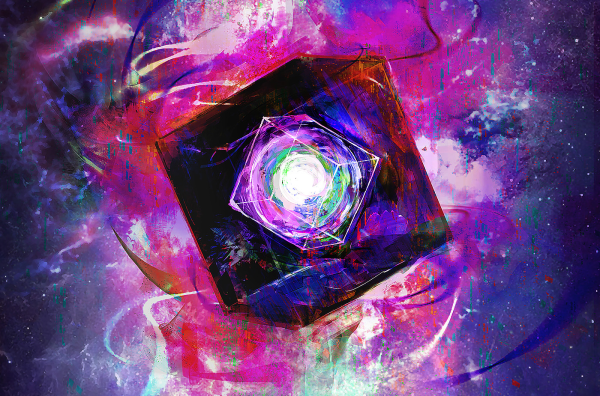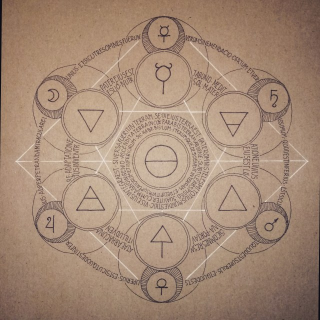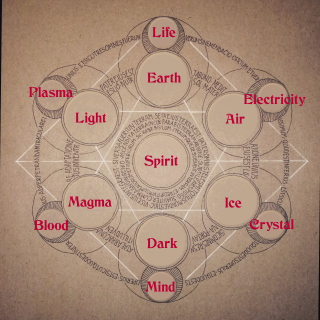The Magicka Atom
Magic as Miralh knows it is a completely isolated concept from any Prime Material the plane has links to. It is not a force, it is not a power bestowed by the Gods, and it is most certainly not a creation myth; quite the contrary. Magic is an element. Down to the very atomic level, it is a substance so material, so physical, that it can appear inside of each and every living being—it is the oxygen to the human body.
This element is known as Magicka. It is not categorized in any particular aspect of the assortment of conventional elements because its nature is arcane, still an ill-understood mystery.
One of Magicka's chief properties is its ability to meld with another element—and then adapt that element's properties as its own. However, Magicka doesn't appear to be capable of bonding with any scientifically recognized 'element' in the same way. Rather, it appears sensitive more to alchemical abstracts; powers of collective natural reactions, states and forms which Magicka can adapt as its own. All bonded Magicka molecules rapidly self-reciprocate their powers between one another when they are of the same element, allowing strong concentrations of the stuff to amount to what we call Affinities. Affinities represent what the dominant elemental Magicka inside of an object or creature is, and what their body will respond most to when said Magicka is interacted with.
This property of magicka response is known as Mana, the collective quantity of active Magicka which can be utilized as an energy source. Mana is quintessential to life because it invented Evolution, allowing these creatures to adapt to their environment.
However, Mana can be taken to two types of extremes: overabundance, and deficiency. In the case of the former, an overly magical creature has become so attuned to their given elemental affinity that their body has rapidly mutated beyond natural methods. Their bodies now thrive upon the extremes of their element's manifestation, be it freezing blizzards, volcanic eruptions, or powerful thunderstorms. The natural Mana of the environment sings to them, and forevermore they live their lives as monstrous entities known as Goeteira (lit. 'Wailing creatures'). The plural of a Goeteira is Goeteimata.
The process of monsterization, or rather the transformation of extreme magical overdose, is known by the eponymous term Apogoeteiosis (lit. 'sinister, bewailing magic'). It is named so after the reportedly excruciating process by which a Goeteira form.
In the latter extreme of mana deficiency—or worse yet, the complete absence of it—a worse fate befalls the humanoid in question. Their body shrivels and wastes away to only the bare minimum to sustain their spirit's vessel, where henceforth they became a cannibalistic ghoul of their former self. These 'mana ghouls,' better known as Chaul (lit. 'mana-burner'), are born from the aforementioned process of Chaulpyrosis: the loss or rapid wasting of mana inside of a living creature. A good example of a Chaul-class creature would be a Vampire; who has lost all ability to produce their own Blood Magicka, and must sustain their mana by consuming that of others.
Chauls and Goeteimata are not necessarily creature types in their own right though; they're more classifications for how magical (or not) a given creature is. Any type of creature can, ultimately, suffer from apogoeteiosis or chaulpyrosis if their mana content is not kept in equilibrium.
When excess Magicka must be expelled, either from an object, creature or environment, it produces what is known as Wild Magic. Similar to apogoeteiosis, but rather than mutate the target it instead causes an uncontrollable effect to manifest as the extreme Magicka concentrate reacts with explosive results. Most of the time, Wild Magic will cause severe harm to the victim, however sometimes it may appear as a harmless phenomena. What many scholars fear, however, is the devastating aftermath of Wild Magic event horizons; they are still capable of inflicting temporal and permanent mutations just like apogoeteiosis does, such as permanently changing the affinity of a creature or changing entire environmental biomes on a whim.
Mages—that is, anyone who is actively manipulating Magicka with intent—tend to behave more like "Arcane Scientists" rather than fantastical warriors of might and magic. It is a very careful chemical procedure, which can be triggered through a number of methods, with new ones being discovered every day. Generally speaking, these methods boil down to: Arcane, Miraculous, Occult, and Primal.
A separate section will be described which discusses more about the nature of sapient creatures utilizing Magicka; for this article's intents and purposes, the usage of Magicka is henceforth dubbed Spellcraft.
Properties
Material Characteristics
Magicka takes on no singular appearance except for in its innate state when it is not bonded to any of its receptive elements. In such a state however, it is rather bizarre for even at the atomic level it is capable of adopting a state of matter: Magicka is a solid, crystalline material. When it bonds to a receptive element, it materializes a different type of crystalline effect, which gradually transitions into a liquid, gas, or even plasma in the most extreme cases. Certain receptive elements may keep Magicka in a permanent solid state.
Physical & Chemical Properties
Magicka is highly reactive to its surroundings, typically considered to be capable of interacting with anything in a 5-foot cubic space around a single atom of itself at a time. This gives it an extreme potency even in the smallest amount, but it is hampered by the fact that unbonded Magicka is incapable of manifesting any magical effects. This is because of the 13th receptive element being a metaphysical substance, which will be described later on.
There is only one consistent rule to magical reactivity: it can never react to more than a single elemental affinity at a time. Hybridization is impossible, as the molecules will cease bonding to anything other than their existing element's relations. (e.g. a Magma Magicka may 'melt' into Blood Magicka if given the right stimuli, but it becomes incompatible with Light Magicka). It should be observed that this is a transformation of Magicka from one elemental affinity to another; it cannot attune to more than one at a time.
Compounds
Geology & Geography
Magicka was omnipresent in the creation of Miralh, however it was still a physical substance which can be reduced to nil in its presence by natural factors. Thus, after an indeterminable period of time since the demiplane was first brought into being, Magicka has become widely dispersed in both the Surface and the Subterranean of Miralh. Though, it is consistently observed that Magicka is always more concentrated towards its epicenter.
Origin & Source
There is no confirmed knowledge about what or where Magicka came from. Some believe that it is a material reflection of Magic from the Prime Material of the Physian Planescape. Others believe it to be a universal element, which would extend to other planes too.
Life & Expiration
Magicka does not expire by natural means, only when it loses exposure to its elemental affinity will it go dormant. Extreme circumstances, such as Water-attuned Magicka being exposed to a lightning bolt, can transform it into Electricity-attuned Magicka.
History & Usage
Everyday use
Magicka is used in many applications of everyday life, for it is the basis of most practical innovations that do not attempt to replicate its effects without relying upon its volatile substance (pragmatic technology).
In medicinal fields, Magicka is the primary component of a type of alchemical concoction known as the Mana Potion. It is a variation of a traditional Health Potion which is designed to prevent chaulpyrosis by administering an appropriate type of dormant mana into a recipient creature. Administering a Mana Potion can also be used to embolden Mages with a temporary increase to their mana reserves without triggering apogoeteiosis, so long as it is consumed in a responsible fashion.
In technological fields, Magicka is an alternative to virtually any elemental construct. A single crystal of Magma Magicka will never cease to burn. A single crystal of Light Magicka will never cease to glow. One of Air would never cease to blow. For all intents and purposes, the most magically embraced societies have built their very way of life around the practical application of magic crystals to their day to day lives. It should be noted, however, that Magicka still has its limitations as an element and cannot be used to replicate every mundane substance; typically speaking, inorganic creations such as clothing, architecture and some complex weapons cannot be inherently replaced by Magicka on the mass scale.
More uses will be detailed at a later date.
Cultural Significance and Usage
Magicka has raised certain controversies regarding if it is truly worthy of human ingenuity or not; that is, can it truly replace the bonafide potential of technological growth. As if bound by the very laws of the planar dimension, Miralh reflects this by inhibiting the reactivity of Magicka around certain artificial substances made by too many elemental combinations.
Furthermore, magical combat has proven a controversial issue when it is used in major populated regions. This is because when two magical effects collide with one another, their affinities are tested for compatibility. If they are compatible, then the effects dissolve into one another harmlessly. If they are not, however, then they repulse each other violently, creating a Wild Magic phenomena. This has led several locations to outright ban the use of magic from the masses, consolidating it only to a select handful individuals.
Finally, the impact of innately magical races has developed more than one case of xenophobia in a civilization. Whether it be from magical envy, or magical disdain, it is not uncommon for a more—or less—magically attuned species to persecute those of an imbalanced variety. A fine traditional example would be that of the versatile Human, a race who's affinity is completely variable from birth and one of the most adaptive of all. This, however, leads them to question those of certain elements, out of fear it is something which they might become themselves. Consequently, it is not unheard of for the average Human being to loathe the more magically inclined of civilized races.
Manufacturing & Products
Magical Items are not enchanted by a passive force or powerful reaction of Magicka but rather are inlaid with it in their very construction, and have become a staple choice of craftsmanship in the civilized realms. The engineering that goes into Magical Items is one of a very finite science, so much so that critics believe it is usually more reliable to use manmade products instead,
A Magical Item must adhere to two rules: The Magicka Element used in the construction or enhancement of a material item must be of a balanced quantity proportionate to the mass of the item in question. (In essence, larger objects require more raw Magicka). Second; the Magicka used must be compatible with its intended object, creature, or environment. Magical Items of a certain Element used in an incompatible circumstance will only produce Wild Magic effects instead, and may even be destroyed in the process. Thus, traditionally it is recommended for professional Mages to keep items of multiple elements stored safe when they know they will be going somewhere wherein their items would react poorly.
However, there are no limitations on what a Magical Item could become. It is even possible to use the intangible Spirit element in the process, though the methods of accessing Spiritual Magicka are beyond manmade methods and rely solely upon the help of otherworldly outsiders to be completed. As described in prior sections however, Magicka does lose its potency when exposed to artificial creations which are too overloaded in their elemental makeup. Thus, for instance, firearms can not be 'enchanted' into Magical Items.
It is believed, however, that Spirit, Mind, and Life Magicka may be utilized to emulate any artificial creation. Thus, Druids have found that creating alternatives to metal armor out of wood and stone can yield an equal effectiveness; Psions have formulated the art of conjuring apparitions and illusions to inflict feelings of pain through false-objects. Both have even learned how to emulate firearms; Druids can do so by forging their weapons out of ivory and other natural materials in their purest state, while Psions have learned to telekinetically command existing objects without altering their composition.
Hazards
Magicka in of itself is a dangerous substance which can elicit very unhealthy side effects, which if not treated will cause apogoeteiosis or chaulpyrosis depending on the circumstance. As a result of this, however, the more sinister and deprived of civilized races have discovered less morally sound means of using Magicka. Poisons, toxins, and other venomous fluids have been wrought from melted Magicka, designed to inflict a magical pain so severe it horrifically transfigures the victim according to its affinity.
Wild Magic has also seen intentional weaponization in some places, with incompatible elements compacted into a singular vessel designed to deliberately fuse them together upon detonation; magical bombs, as it were. Grenades, mortars, cannons and more are able to fire these types of munitions to deliver arcane results that do not end well for their victims.
0Mgc
1 Magicka
Type
Elemental / Molecular
Odor
Odorless.
Taste
Tasteless.
Color
Colorless.
Density
1mp
Common State
Solid crystal.
Remove these ads. Join the Worldbuilders Guild










